47 White Flowering Trees (with Pictures): Identification Guide
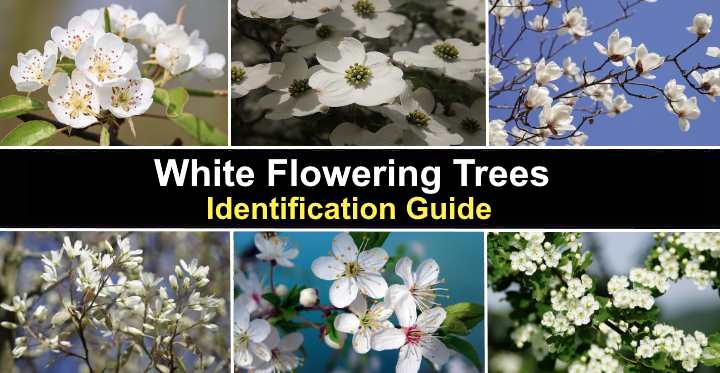
White flowering trees are a beautiful addition to any garden landscape. These trees, with their delicate white blooms, can create a stunning focal point and add a touch of elegance to your outdoor space. Whether you’re looking for a small white-ornamental tree or a larger shade tree, there are plenty of trees with white flowers to choose from. From the iconic cherry blossom tree to the fragrant magnolia, white flowering trees offer beauty and grace in every season.
Magnolia trees are some of the most stunning evergreen trees with white flowers. Many white blossom deciduous trees like crabapple trees, cherry blossom trees, and pear trees fill gardens in spring with masses of fragrant white flowers.
Do you want to find the best white-flowering trees to enhance the aesthetics of your front or backyard? If so, this list has the top ornamental and shade trees for garden landscapes.
White Flowering Trees (with Pictures): Identification Guide
Please read on to find descriptions and pictures in this list of the top white-flowering trees for garden landscapes.
White Flowering Crape Myrtle Tree (Lagerstroemia indica)
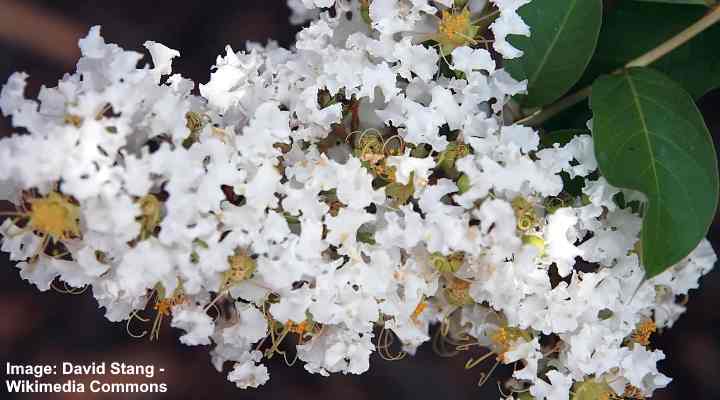
White flowering crape myrtle trees are beautiful additions to any landscape. They are known for their cone-shaped clusters of white, crape-paper-like flowers that bloom repeatedly throughout the summer. The stunning white flowers contrast beautifully against the tree’s dark green leaves. In the fall, crape myrtle trees have yellow foliage.
Crape myrtle trees with white flowers thrive in well-drained, average soil with medium moisture. You can plant white crape myrtle trees as specimen trees, foundation plants, or in groups to create a stunning display. Other varieties of crape myrtle bloom in summer and fall with pink, purple, red, and lilac flowers.
With proper care, white flowering crape myrtle trees can provide years of beauty to your landscape.
Mature Size: 5 to 25 ft. (1.5 – 7.5 m) tall, depending on the species
USDA Hardiness Zones: 6 to 9
Sun: Full sun exposure
Japanese Crape Myrtle (Lagerstroemia subcostata var. fauriei)

Japanese crape myrtle is a beautiful multi-trunk tree with stunning white flowers. Abundant clusters of showy crape-like flowers bloom in cone-like panicles. The bright flowers fill summer gardens with color and fragrance thanks to their long blooming season. The Japanese crape myrtle tree also has leathery leaves that turn golden yellow in the fall.
Japanese crape myrtle trees thrive in sunny sites with well-drained soil. The shrub-like tree performs well as a white-flowering lawn tree, specimen plant, or grouped to create a beautiful white floral display. The trees are known for their ability to bloom throughout the summer and fall, adding color and beauty to any landscape.
Its four-season ornamental features are thanks to its attractive light brown bark that peels to reveal cinnamon inner bark.
Mature Size: 20 to 30 ft. (6 – 9 m) tall and wide
USDA Hardiness Zones: 6 to 9
Sun: Full sun exposure
Bigleaf Magnolia Tree (Magnolia macrophylla)

The bigleaf magnolia tree is recognizable by its large, broad leaves and showy star-shaped creamy-white fragrant flowers. White magnolia flowers have white lance-shaped petals with a rose-purple base. Additionally, the tree’s large deciduous oblong leaves grow 3 ft. (1 m) long and 1 ft. (0.3 m) wide. Red egg-shaped fruits appear in late summer.
Bigleaf magnolia is native to North America and thrives in organically rich, well-drained soils. The native tree performs well as a shade tree or specimen plant in a large garden landscape. The beautiful flowers attract pollinators such as bees and butterflies in late spring and summer.
Mature Size: 30 to 40 ft. (9 – 12 m) tall and wide
USDA Hardiness Zones: 6 to 9
Sun: Full sun or partial shade
Southern Magnolia (Magnolia grandiflora)
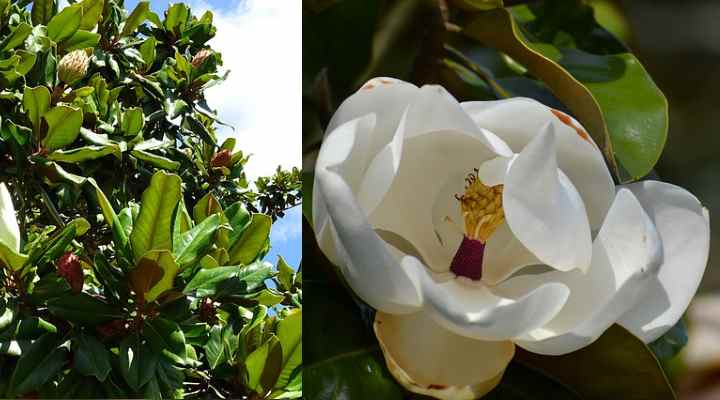
White flowering Southern magnolia tree is identified by its dense evergreen foliage, showy, white cup-shaped aromatic flowers, and cone-like seed pods containing red seeds. Its thick leathery, oblong leaves, fragrant white flowers, and rounded crown make this majestic evergreen tree an attractive ornamental shade tree in southern landscapes. The white flowers bloom in late spring and early summer.
Southern magnolias thrive in neutral to rich soils that have excellent drainage. When established, the white-flowering tree tolerates sandy or heavy clay soils. However, it’s not tolerant of extreme drought or pollution. It’s a fast-growing, pest-free tree with little maintenance requirements when growing in warm climates.
Southern magnolias are known for their tolerance to heat and humidity, making them a great tree for southern gardens.
Mature Size: 60 to 80 ft. (18 – 24 m) tall and 30 to 50 ft. (9 – 15 m) wide
USDA Hardiness Zones: 7 to 10
Sun: Full sun or partial shade
Star Magnolia (Magnolia stellata)

Star magnolia is a small deciduous tree known for its eye-catching, star-shaped, white fragrant flowers. The white magnolia flowers have slender, pure petals that give them a delicate appearance. Blooming in early spring, the lovely flowers contrast with the luscious dark green foliage, making them a beautiful addition to any landscape.
Star magnolias are one of the earliest flowering trees in spring to bloom. The small ornamental trees prefer well-drained, slightly acidic, moist soil. In a landscape, you can grow the tree to create a focal point in small landscapes. Star magnolias also perform well in foundation plantings, as an informal hedge, or growing as a large shrub-like lawn tree.
Mature Size: 10 to 20 ft. (3 – 6 m) tall and 8 to 10 ft. (2.4 – 3 m) wide
USDA Hardiness Zones: 4 to 9
Sun: Full sun or partial shade
Sweetbay Magnolia (Magnolia virginiana)

The sweetbay magnolia tree has cup-shaped creamy-white flowers that bloom from May to June. The attractive flowers are 2” to 3” (5 – 7.5 cm) across and give off a fragrant scent. This magnolia tree has large glossy lanceolate or elliptical leaves and a rounded to pyramidal crown.
Sweetbay magnolia grows as an evergreen tree in southern states and a deciduous magnolia bush in colder climates. The fast-growing tree is low-maintenance and can tolerate clay or wet soil, as well as air pollution.
In warmer climates, sweetbay magnolia is popular as a specimen lawn tree, and it is also ideal for foundation plantings, shrub borders, or growing in pots.
Mature Size: 10 – 35 ft. (3 – 10 m) tall and wide
USDA Hardiness Zones: 5 to 10
Sun: Full sun or partial shade
English Hawthorn (Crataegus laevigata)
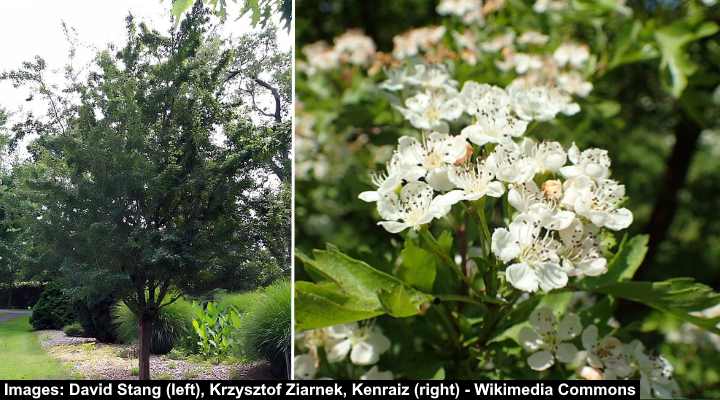
English hawthorn is a small deciduous tree prized for its clusters of beautiful white five-petalled flowers in the spring. The masses of white hawthorn blossoms are small and have a sweet fragrance, creating a stunning spring floral display. The small ornamental tree also features shiny green leaves, large thorns, red fruits in the fall, and distinct zig-zag branches.
English hawthorn trees are hardy and adaptable, thriving in a variety of soil types, including clay, loam, and sandy soils. The versatile ornamental trees perform well as a security hedge or specimen tree. Its tolerance to salty air makes it a great addition to coastal landscapes and wildlife gardens.
Mature Size: 15 to 20 ft. (4.5 – 6 m) tall and wide
USDA Hardiness Zones: 5 to 8
Sun: Full sun
Flowering Cherry Tree (Prunus serrulata)
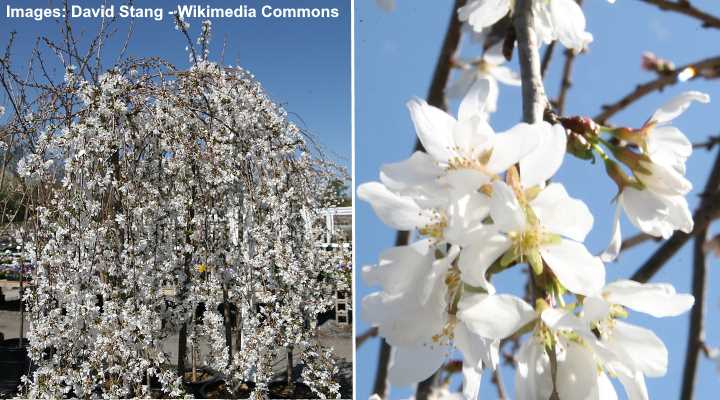
A picture of the small weeping cherry tree Prunus serrulata ‘Snow Fountain’
Several varieties of flowering cherry trees are known for their stunning display of white flowers. Masses of fragrant white flowers cover the tree’s vase-shaped spreading crown throughout spring. The cherry blossom tree flowers are usually double-blooms with ruffled petals creating a beautiful contrast against the tree’s dark green foliage.
Small white-flowering cherry trees prefer well-drained, fertile soil and full sunlight. They are relatively low-maintenance and can be planted as specimen trees or in groups to create a stunning floral display. These trees also provide beautiful fall foliage, with leaves turning shades of yellow, orange, and red.
Types of cherry blossom trees with white flowers include the following:
Prunus’ Shirotae’—Pure white spring blossoms growing on a small deciduous tree with a flat canopy.
Prunus’ Shogestu’—Showy white double flowers growing in large hanging clusters 6” (15 cm) long.
Prunus’ Snow Fountains’—This spectacular weeping cherry blossom tree has small snow-white flowers covering cascading branches throughout spring and early summer.
Prunus’ Tai-Haku’—Large brilliant white cherry blossoms growing in large clusters that cover the branches in spring.
Mature Size: 15 to 20 ft. (4.5 – 6 m) tall and wide
USDA Hardiness Zones: 5 to 8
Sun: Full sun exposure
Yoshino Cherry (Prunus x yedoensis)
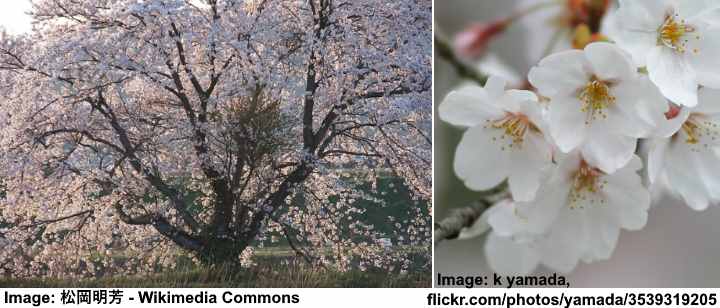
Yoshino cherry trees are known for their stunning, white-pink blossoms that cover the tree in early spring, creating a breathtaking floral display. Other identifying features of Yoshino cherry trees are their dark green leaves, fall shades of reds, oranges, and yellows, and small black ornamental fruits.
Prized in landscapes for their great beauty, the cherry blossom trees have an upright, spreading habit. They perform well in a range of well-drained soils if they get at least four hours of sunlight daily and regular watering. Yoshino cherry trees are ideal for planting as lawn trees or specimen plants.
Mature Size: 20 to 30 ft. (6 – 9 m) tall and have a wider spread
USDA Hardiness Zones: 5 to 8
Sun: Full sun or partial shade
White Flowering Almond Tree (Prunus glandulosa alboplena)
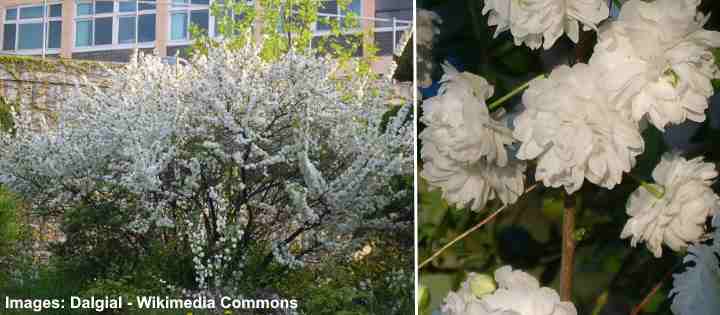
The compact white flowering almond tree is known for its delicate, white flowers that bloom in early spring, gracefully adorning its bare branches. These exquisite blossoms, resembling fluffy white clouds, add a touch of elegance and serenity to your garden. With vibrant green leaves that emerge after the blooming period, this tree stands out throughout the year, providing a lush backdrop for its mesmerizing flowers.
This ornamental tree boasts beautiful white flowers that bloom in early spring, adding a touch of elegance and charm to your outdoor space. Whether planted as a focal point, border tree, or massed for a striking visual impact, the white flowering almond tree offers versatility in garden design.
Mature Size: 6 to 8 ft. (1.8 – 2.4 m)
USDA Hardiness Zones: 4 to 8
Sun: Full sun
White Flowering Pear tree (Pyrus spp.)
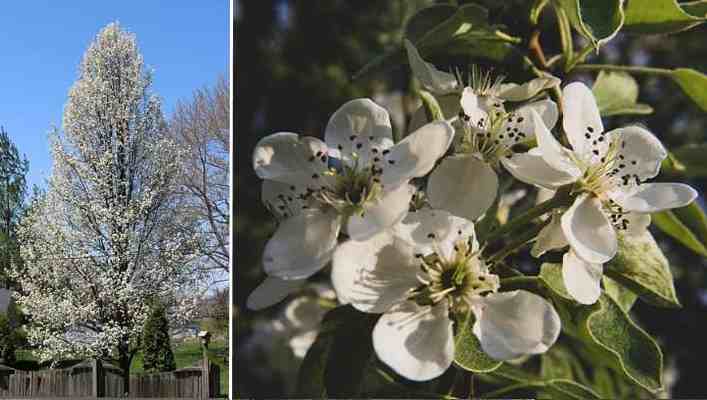
White flowering pear trees are stunning additions to any landscape thanks to beautiful clusters of creamy-white flowers. Blooming in spring, showy, fragrant white flowers contrast beautifully against the tree’s glossy green leaves. In the fall, the leaves turn shades of yellow, orange, and red, adding even more beauty to the ornamental tree.
White flowering pear trees are adaptable and can thrive in various soil types, from clay to sandy soil, as long as the soil is well-drained. Landscaping uses for flowering pear trees include specimen trees and small shade trees. They are compact enough for small backyards. No pruning is necessary to keep the tree’s attractive shape.
Mature Size: 20 to 30 ft. (6 – 10 m) tall and wide, depending on the species
USDA Hardiness Zones: 6 to 9
Sun: Full sun
White Flowering Crabapple Trees (Malus spp.)
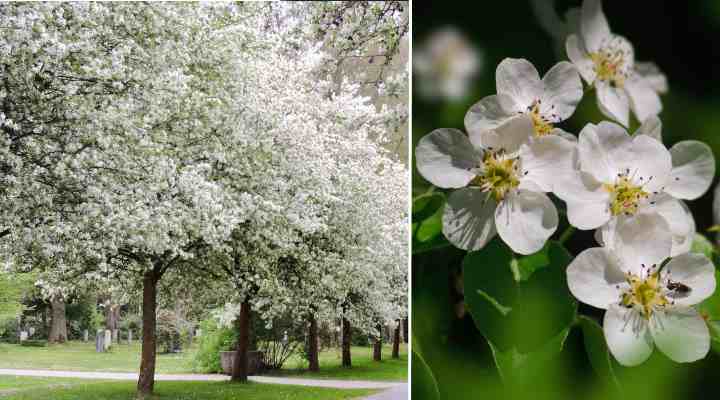
The crabapple tree is a small, deciduous fruit-bearing ornamental tree known for its abundant clusters of fragrant white flowers. It’s an attractive multi-stemmed tree with pink flower buds, dark green lobed leaves, and clusters of small cherry-like pomes hanging from twisted branches. Its bloom time is mid to late spring.
Crabapple trees are relatively small, suitable for smaller landscapes or accent trees in larger yards. They are also relatively low-maintenance, requiring minimal pruning and care. Other uses in a landscape include growing as a privacy screen, lawn tree, or flowering hedge.
Crabapple trees are a beautiful addition to any landscape, providing three-season beauty with their flowers, fruits, and zig-zag branching habit.
Types of crabapple trees with white flowers include the following:
Sargent Crabapple (Malus sargentii) – A dwarf landscape tree with masses of sweetly-scented white flowers. ‘Sargent’ crabapple trees grow between 6 and 10 ft. (1.8 – 3 m) tall with a spread up to 12 ft. (3.6 m) wide.
Lollipop Crabapple (Malus ‘Lollizam’) – The compact dwarf crabapple tree produces clusters of fragrant white flowers every spring. It has a straight thin trunk and rounded growth and it grows up to 8 ft. (2.4 m) high.
Snowdrift Crabapple (Malus ‘Snowdrift’) – The ornamental ‘Snowdrift’ crabapple trees have fragrant clusters of snow-white flowers in spring. Crabapple ‘Snowdrift’ trees grow between 15 and 20 ft. (4.5 – 6 m) tall.
Siberian Crabapple (Malus baccata) – Siberian crabapples are cold hardy crabapple trees with showy clusters of fragrant white flowers that bloom in early spring. The tall trees can reach 30 or 40 feet (9 – 12 m).
Mature Size: 6 to 40 ft. (1.8 – 12 m) tall and wide, depending on the species
USDA Hardiness Zones: 5 to 9
Sun: Full sun
Carolina Silverbell Tree (Halesia carolina)
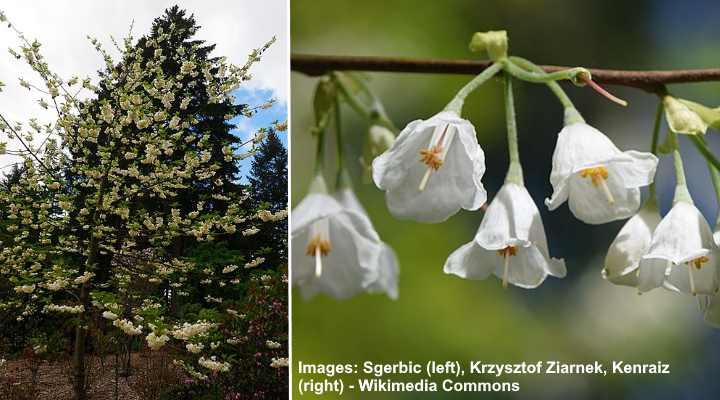
Carolina silverbell trees are identified by their delicate white bell-shaped flowers that hang gracefully from the branches. Blooming early in the season, the dangling white flowers are fragrant and attract pollinators such as bees and butterflies. The tree’s leaves are vibrant green with serrated edges and turn yellow in the fall.
Carolina silverbell trees are easy to grow and thrive in moist, well-drained soils. You can grow the deciduous plant as a large ornamental shrub or small tree. It performs well in larger landscapes as a specimen lawn tree, shrub border, or understory tree. The tree’s beautiful white flowers and medium size add a touch of elegance to any garden.
Mature Size: 30 to 40 ft. (10 – 12 m) tall and 20 to 35 ft. (6 – 11 m) wide
USDA Hardiness Zones: 4 to 8
Sun: Partial shade
Japanese Snowbell (Styrax japonicus)
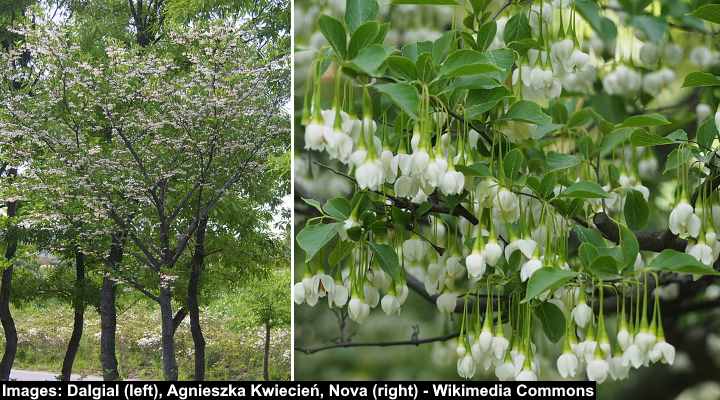
Japanese snowbell is a small deciduous tree known for its delicate bell-shaped white flowers blooming gracefully on the branches. The attractive flowers have yellow stamens and a sweet fragrance and hang in clusters from branches. The tree’s dark green leaves turn yellow in the fall, adding to its beauty.
In addition to its stunning white flowers, the Japanese snowbell has attractive bark that peels and reveals a smooth, cinnamon-colored trunk.
Japanese snowbell trees prefer acidic, humus-rich, well-drained soils. When sheltered from cold winds, the showy, elegant landscaping trees perform well in woodland gardens, in containers, or as specimen trees. It’s a low-maintenance ornamental tree without any significant pest or disease issues.
Mature Size: 20 to 30 ft. (6 – 9 m) tall and wide
USDA Hardiness Zones: 6 to 8
Sun: Partial shade
Northern Catalpa Tree (Catalpa speciosa)

The northern catalpa tree is a deciduous tree recognized by its large heart-shaped leaves and clusters of white, trumpet-shaped flowers. The spring-blooming white flowers have purple speckles and yellow blotches. The attractive white flowers are followed by long, bean-like seed pods. The tree’s leaves turn yellow in the fall, adding to its seasonal interest.
Northern catalpa trees are adaptable and can grow in a variety of soil types, including clay, loam, and sandy soils. The white-flowering trees perform well as shade trees or specimen trees in large landscapes.
Mature Size: 50 to 70 ft. (15 – 21 m) tall and 20 to 50 ft. (6 – 15 m) wide
USDA Hardiness Zones: 4 to 8
Sun: Full sun to partial shade
Horse Chestnut (Aesculus hippocastanum)
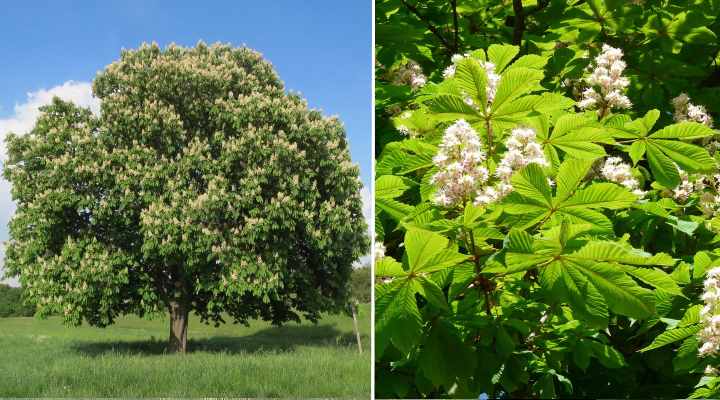
Horse chestnut trees are easily recognizable for their upright cone-like clusters of showy white flowers and large, distinctive leaves. The pinkish-white flowers bloom in late spring. The conical clusters measure 12” (30 cm) tall. The large spatula leaves are palmately compound and turn a beautiful yellow or orange color.
Horse chestnut trees are relatively low-maintenance trees. Due to their immense size, they are ideal as shade trees or ornamental trees in large, open landscapes or park settings.
Another iconic feature of horse chestnut trees is their large spiny capsules that encase a shiny brown nut.
Mature Size: 50 to 75 ft. (15 – 23 m) tall and wide
USDA Hardiness Zones: 3 to 8
Sun: Full sun or partial shade
Ohio Buckeye Tree (Aesculus glabra)
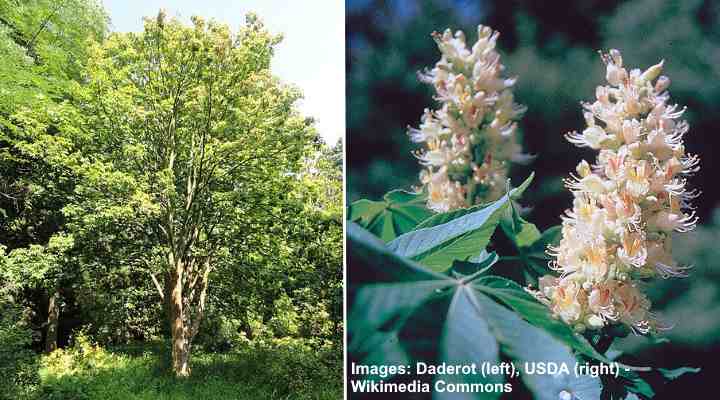
The Ohio buckeye tree is known for its showy white flowers, palmate leaves, and distinctive fruit resembling a buck’s eye. Like horse chestnut trees, the deciduous tree produces conical clusters of white, tubular flowers in spring. After blooming, the flowers give way to round, spiky fruit capsules that contain shiny brown nuts.
Also called the Texas buckeye, the tall, expansive landscaping trees prefer well-drained, moist, fertile soil. Their appeal in landscapes is for their shade, attractive spring flowers, and dense canopy. Native to the southern United States, the buckeye tree is common in parks and open landscapes.
Mature Size: 20 to 40 ft. (6 – 12 m) tall and wide
USDA Hardiness Zones: 3 to 7
Sun: Full sun or partial shade
White Fringe Tree (Chionanthus virginicus)
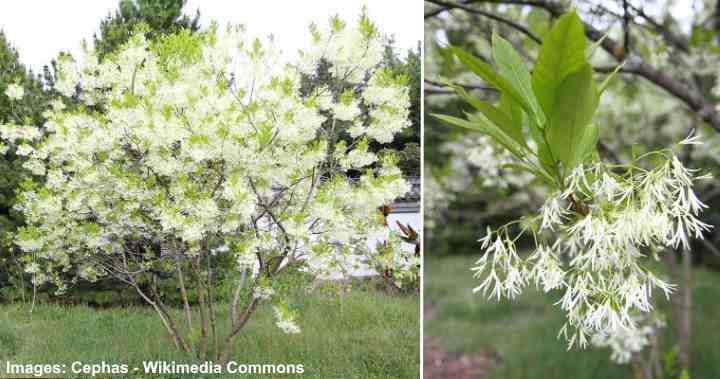
White fringe tree is native to the eastern United States and is prized for its masses of cream-white fragrant flowers. The attractive fringe-like white flowers have wiry petals that bloom in the spring. Additionally, the fringe tree has lanceolate leaves that turn yellow in the fall and clusters of dark blue summer fruits.
White fringe trees adapt to a variety of soil types and are exceedingly easy to grow. You can grow the small white-flowering trees in mixed borders, as a specimen plant, or in groups for a dramatic floral display.
With their beautiful white flowers and attractive foliage, white fringe trees are a lovely addition to any landscape.
Mature Size: 12 to 20 ft. (3.6 – 6 m) tall and wide
USDA Hardiness Zones: 3 to 9
Sun: Full sun to partial shade
Flowering Dogwood (Cornus florida)
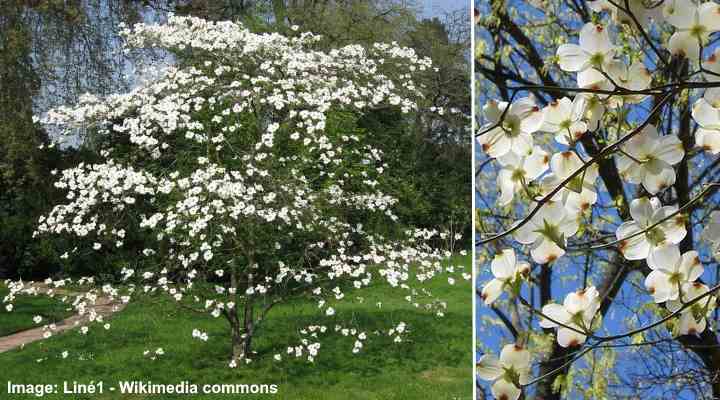
Flowering dogwood is a small deciduous tree famous for its beautiful white bract-like flowers. White-flowering dogwoods are particularly stunning, with large, showy star-shaped blooms, dark green leaves, bright red summer berries, and purple and dark red fall colors. Additionally, its distinctive bark resembling alligator skin gives the tree four-season interest.
Flowering dogwoods prefer well-drained, acidic soil and partial shade. The ornamental trees also perform well as understory trees in woodland gardens. Or you can plant them in your front or backyard near patios or lawns.
Many gardeners consider white dogwoods one of the most attractive small flowering trees.
Mature Size: 15 to 30 ft. (4.5 – 9 m) tall and wide
USDA Hardiness Zones: 5 to 9
Sun: Partial shade
Giant Dogwood (Cornus controversa)
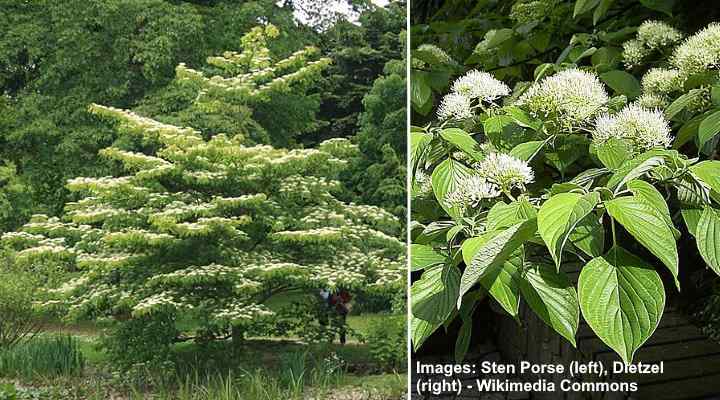
One of the most stunning white-flowering trees is the giant dogwood. Giant dogwood puts on a spectacular floral show thanks to its masses of creamy-white flowers, green or variegated leaves, and black berries. The white flowers and attractive leaves grow on layered horizontal branches—a reason it’s called the wedding cake tree.
Giant dogwood thrives in organically fertile, acidic, well-drained soil. Its compact habit and ornamental value make it a great focal point or specimen tree in a small to medium-sized garden or as a shade tree in larger landscapes. The tree is also a favorite among birds, as its berries are a food source.
Mature Size: 30 to 40 ft. (9 – 12 m) tall and wide
USDA Hardiness Zones: 5 to 8
Sun: Partial shade to full sun
Tea Plant (Camellia sinensis)

Tea plant is a white-flowering evergreen shrub or small tree with aromatic tea leaves. While not known for their flowers, tea plants produce small white flowers with yellow centers. Together with their glossy green leaves and fragrant white flowers, tea plants are excellent small trees for landscaping shaded areas of your garden.
Tea plants thrive in acidic, well-drained, evenly moist soils. They are best suited for temperate climates. You can grow tea plants in containers or the ground. In addition to their aesthetic appeal, you can also use the leaves to make various types of tea.
Mature Size: 10 to 15 ft. (3 – 4.5 m) tall and 6 to 10 ft. (1.8 – 3 m) wide
USDA Hardiness Zones: 7 to 9
Sun: Partial shade
Japanese Lilac Tree (Syringa reticulata)
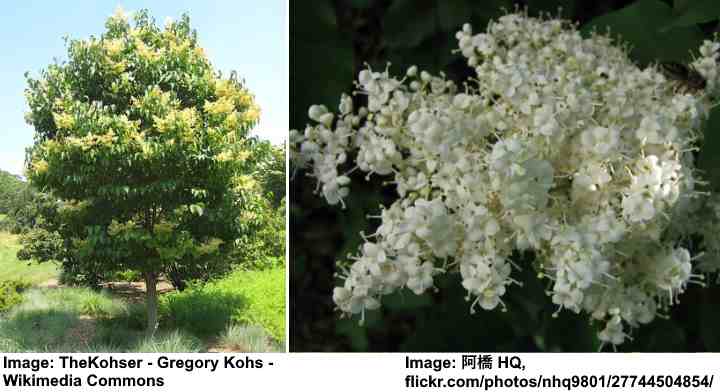
Japanese lilac tree is a small to medium-sized deciduous tree known for its clusters of fragrant, creamy-white flowers. Other identifying features of Japanese lilac are its reddish-brown peeling bark and sharply-tipped dark green leaves. The white lilac flowers bloom in early summer and last several weeks, creating a stunning floral display.
Japanese lilac trees are adaptable and can tolerate a wide range of soil conditions, including clay and sandy soils. You can grow the small trees as foundation plantings, specimen trees, or attractive landscaping trees. The trees are low-maintenance and ideal for garden landscapes in temperate and cooler climates.
Mature Size: 20 to 30 ft. (6 – 9 m) tall and 15 to 25 ft. (4.5 – 7.5 m) wide
USDA Hardiness Zones: 3 to 7
Sun: Full sun to partial shade
American Elderberry (Sambucus canadensis)

American elderberry is a deciduous shrub or small tree that produces clusters of small, lemon-scented white flowers in the spring. The flat-topped white flower clusters contrast nicely with lush lance-shaped green leaves. After flowering, clusters of glossy edible black berries appear. American elderberries are known for their fast growth rate.
Native to North America, elderberries thrive in wetland areas, stream banks, and open woods. The suckering shrub can be trained to grow as a tree. Or you can allow the bushy plant to form an informal screen or hedge. Its fragrant white flowers attract pollinators, and the berries are a magnet for birds and other wildlife.
Mature Size: 5 to 12 ft. (1.5 – 3.7 m) tall and wide
USDA Hardiness Zones: 3 to 9
Sun: Full sun to partial shade
Whitebeam (Sorbus aria)
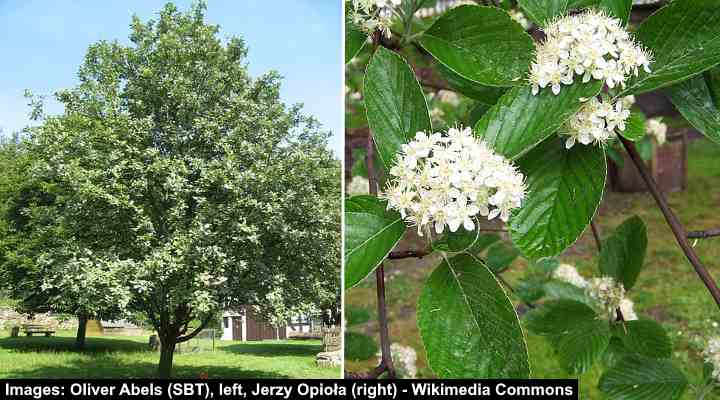
Whitebeam is a white-flowering deciduous tree that can be identified by its silvery, fuzzy underside leaves, beautiful white spring flowers in clusters, and small red berries in the fall. Whitebeam trees have oval-shaped leaves with a silvery-white underside, which lends the tree its name. With its distinctive foliage, Whitebeam trees offer ornamental appeal throughout all four seasons.
Versatile whitebeam trees thrive in various well-draining soil types, including clay, loam, and sandy soil. In addition to their landscaping features—white flowers, attractive foliage, and red berries—whitebeam trees provide important habitat and food for wildlife.
Whitebeam trees are excellent trees for use in landscaping as specimen trees, in hedgerows, or as part of a mixed planting.
Mature Size: 25 to 30 ft. (8 – 9 m) tall and up to 25 ft. (8 m) wide
USDA Hardiness Zones: 4 to 7
Sun: Full sun to partial shade
Swedish Whitebeam (Sorbus intermedia)
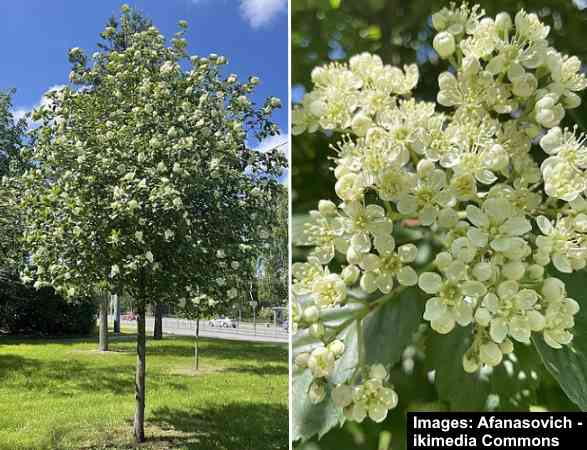
Native to Northern Europe, the Swedish whitebeam is an attractive landscaping tree with white flowers. Recognizable features of the tree are its deeply-lobed dark green leaves, abundant clusters of brilliant white, tiny flowers, and bright red berries. The tree has a rounded crown of dense foliage that turns yellow in the fall.
Swedish whitebeam is a hardy tree that can tolerate a wide range of conditions. The white-flowering tree tolerates urban conditions and salty air, making it suitable for city or coastal planting. You can easily grow it as a shade tree in large, open landscapes.
Mature Size: 30 to 40 ft. (9 – 12 m) tall and wide
USDA Hardiness Zones: 5 to 8
Sun: Full sun or partial shade
Devilwood (Cartrema americanus)
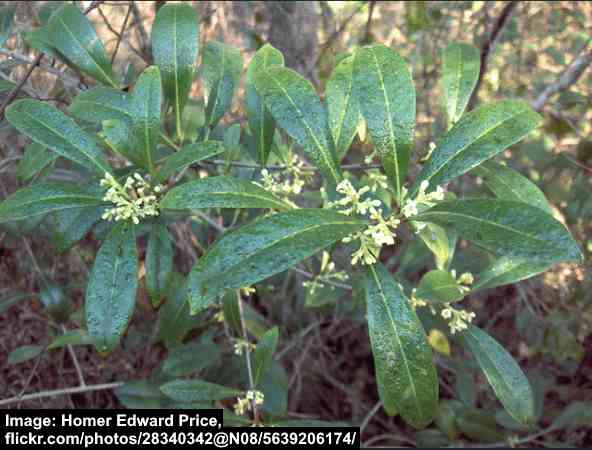
The Devilwood, also known as American olive, is a small evergreen tree native to the southeastern United States. This tree has fragrant white flowers that add a delightful scent to any garden or landscape. Additionally, the Devilwood tree produces green leaves with wavy margins and dark blue drupes. Its charming tiny white flowers, blooming in late spring, further enhance the tree’s beauty.
Devilwood gets its name from its heavy, strong, exceedingly tough wood. For best growth, plant the tree in moist, well-drained soils. Thanks to their attractive dense foliage and fragrant flowers, devilwood trees are excellent landscaping trees in small gardens as a specimen plant or barrier.
Mature Size: 10 to 30 ft. (3 – 9 m) tall and wide
USDA Hardiness Zones: 6 to 9
Sun: Full sun to deep shade
Black Locust (Robinia pseudoacacia)

Black locust is identified as a deciduous tree with thorny bark and clusters of fragrant, white spring flowers. Masses of white pea-like white flower clusters dangle from black branches. The tree’s foliage is a bright green color and comprises large compound leaves of small oval leaflets. Its fall foliage color is yellow.
Native to North America, spine-covered black locust trees are known for their ability to grow in difficult conditions. The tree grows rapidly and thrives in dry to medium soils with excellent drainage.
Other identifying features of black locust trees are their deeply furrowed rough bark, long, flat, purplish-brown seed pods, and snow-white flowers.
Mature Size: 30 to 50 ft. (9 – 15 m) tall and wide
USDA Hardiness Zones: 4 to 9
Sun: At least six hours of sunshine daily
Allegheny Serviceberry (Amelanchier laevis)

Allegheny serviceberry is a deciduous tree known for its beautiful white flowers and edible berries. Ornamental features of the serviceberry tree include clusters of small, white, star-shaped flowers, purplish-bronze emerging leaves, and blue-black summer berries. This white-flowering deciduous tree has a four-season appeal thanks to its attractive smooth bark and fine-textured branching habit.
Allegheny serviceberry is native to North America and thrives in well-drained, acidic soil. It tolerates a variety of conditions, including clay soil and urban environments. The small ornamental tree grows well as a specimen tree, flowering hedge, privacy screen, and in native plant garden.
Mature Size: 15 to 25 ft. (4.5 – 7.5 m) tall and wide
USDA Hardiness Zones: 4 to 9
Sun: Full sun to partial shade
Shadblow Serviceberry Tree (Amelanchier canadensis)
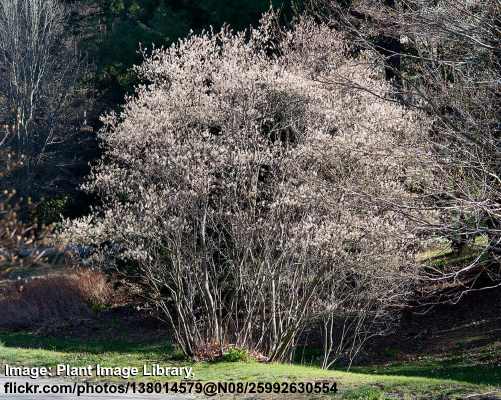
The shadblow serviceberry (also known as Canadian serviceberry and thicket serviceberry) is a shrub-like small tree that produces clusters of white flowers when it blooms in March and April. The fragrant serviceberry white flowers emerge from pink buds in early spring. The five petals form a fan out from the center, creating a star shape.
The shadblow serviceberry also produces dark green, finely-toothed oblong leaves and edible purple berries. It has smooth bark that develops furrows as it matures. The tree thrives in partial shade and moist soil.
To grow the shrub-like serviceberry plant as a specimen tree, remove the suckers in winter. The beautiful tree develops a dome-shaped crown that fills with delicate aromatic flowers in early spring. Grow it as a specimen tree or a flowering living fence.
Mature Size: 15 to 25 ft. (4.5 – 7.5 m) tall and up to 20 ft. (6 m) wide
USDA Hardiness Zones: 3 to 8
Sun: Full sun with some afternoon shade
Angel’s Trumpet (Brugmansia suaveolens)
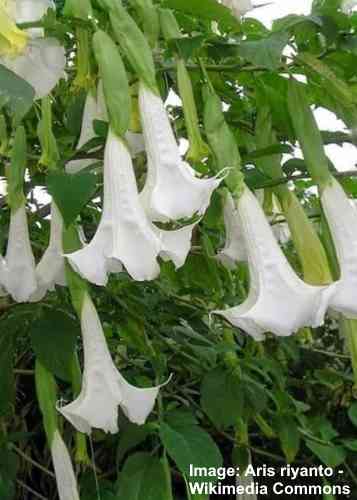
Flowering Angel’s trumpet tree is easily identifiable due to its stunning large, trumpet-shaped white flowers dangling from branches. The eye-catching shrub or small tropical tree blooms throughout summer until fall. It’s characterized by mid-green leaves, highly fragrant funnel flowers, and an attractive vase shape. The exotic white flowers measure 12” (30 cm) long.
Angel’s Trumpet is native to South America and thrives in warm climates. You can grow the tropical tree in organically rich, fertile soil that drains well. It’s ideal for beds and borders, a specimen plant, or to add an exotic touch to decks or patios.
It’s important to note that all parts of the Angel’s Trumpet tree are toxic if ingested. So, you should be careful when planting the tree in landscapes where children or pets play.
Mature Size: 3 to 8 ft. (1 – 2.4 m) tall and 2 to 4 ft. (0.6 – 1 m) wide
USDA Hardiness Zones: 9 to 11
Sun: Full sun or partial shade
American Yellowwood (Cladrastis kentukea)
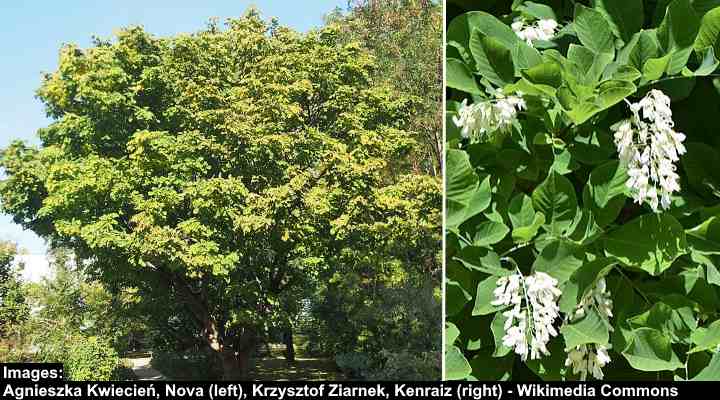
American yellowwood is a deciduous tree with white flowers native to the southeastern United States. Ornamental features of the flowering tree are its beautiful clusters of fragrant, white flowers, yellowish-green leaves that turn bright yellow in the fall, and dangling seed pods. The white flowers are pea-like and hang in long, drooping clusters, creating a stunning display throughout summer.
American yellowwood trees thrive in moist, well-drained soil and full sun. The tree is ideal as a lawn tree, planted near patios and decks, or a shade tree in a medium or large backyard.
Mature Size: 30 to 50 ft. (9 – 15 m) tall and 40 to 55 ft. (12 – 15 m) wide
USDA Hardiness Zones: 4 to 8
Sun: Full sun
Japanese Stewartia (Stewartia pseudocamellia)

Japanese Stewartia—or false camellia—is a deciduous tree with stunning white camellia-like flowers. The flowers have a yellow center and bloom in late spring to early summer. The tree’s dark green leaves turn vibrant shades of orange, red, and purple in the fall, providing a beautiful display of autumn colors.
Japanese Stewartia trees thrive in well-drained, acidic soil and prefer partial shade to full sun. They are relatively low-maintenance trees and can be used as specimen trees or planted in groups for a striking effect. The tree’s attractive bark adds to its appeal, with exfoliating patches revealing a beautiful mosaic pattern.
Mature Size: 20 to 40 ft. (6 – 12 m) tall and wide
USDA Hardiness Zones: 5 to 8
Sun: Partial shade to full sun
Sourwood tree (Oxydendrum arboreum)
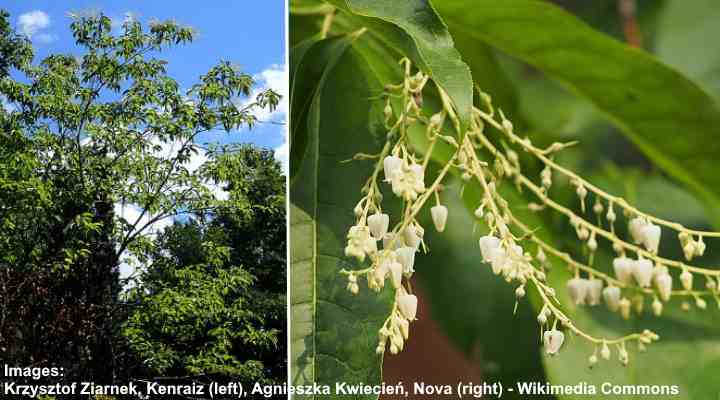
The sourwood tree is a slow-growing deciduous tree prized for its clusters of white, fragrant flowers. The tree’s bloom time is late spring and early summer, where abundant clusters of urn-shaped creamy-white flowers decorate the tree. The tree’s foliage turns a stunning red, orange, or purple color in the fall, making it a standout in any landscape.
Sourwood trees prefer acidic, organically rich, well-drained soils. The ornamental tree, with its lily-of-the-valley white flowers, tolerates drought, salty air, and summer heat. You can plant sourwood trees in shade gardens as specimen, lawn, or patio trees.
Mature Size: 20 to 30 ft. (6 – 9 m) tall and wide
USDA Hardiness Zones: 5 to 9
Sun: Full sun or partial shade
Tree Hydrangea (Hydrangea paniculata ‘Grandiflora’)
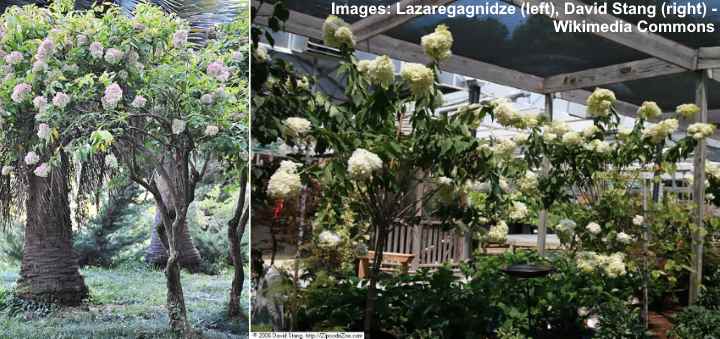
The tree hydrangea is a stunning addition to any garden or landscape to add romantic beauty. The hydrangea tree is known for its large cone-like clusters of white flowers that bloom from summer through fall. The white flowers contrast beautifully against the tree’s dark green leaves, creating a striking visual display.
The hydrangea tree thrives in well-drained soil and tolerates humidity, heat, and urban conditions. You can plant this hydrangea as a hedge, foundation planting, focal point in your garden, or a mixed border. Hydrangea trees are also popular for adding height and dimension to flower beds and borders.
Unlike other hydrangea varieties, the ‘Grandiflora’ flowers have stable white colors regardless of the soil’s pH level.
Mature Size: 10 to 25 ft. (3 – 7.5 m) tall and wide
USDA Hardiness Zones: 3 to 9
Sun: Full sun to partial shade
White Frangipani Tree (Plumeria obtusa)
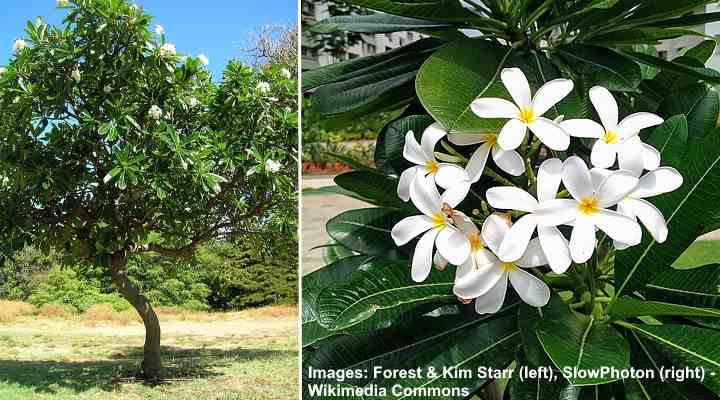
The white frangipani is a tropical tree prized for its beautiful, fragrant white flowers. The exotic white flowers have spoon-shaped white petals with a yellow base. These contrast with the tree’s shiny dark green leaves. In addition, the brilliant white flowers are highly fragrant, adding to the tree’s ornamental appeal.
White frangipani trees only perform well in tropical climates. They are tolerant of salt and drought and thrive in full sun and well-drained soil. Landscaping ideas for the white-flowering frangipani tree include coastal gardens, patio trees, or part of a mixed shrub border.
Mature Height: 10 to 25 ft. (3 – 7.5 m)
USDA Hardiness Zones: 10 to 12
Sun: Full sun exposure
White Eastern Redbud (Cercis canadensis alba)

White eastern redbud is a stunning tree with white flowers that bloom in early spring. The clusters of pea-like white flowers cover bare branches, creating a dramatic floral display. In late spring and early summer, heart-shaped leaves emerge green and turn yellowish-green in the fall.
White eastern redbuds prefer dry, well-drained soil and can tolerate a variety of soil types. In the hottest regions, partial shade is ideal, but the best blooming occurs in full sun. The white-flowering eastern redbud attracts pollinators early in the season. White redbuds perform well as a specimen plant or in shrub borders.
Mature Size: 20 to 30 ft. (6 – 9 m) tall and wide
USDA Hardiness Zones: 4 to 9
Sun: Full sun or partial shade
Loblolly Bay (Gordonia lasianthus)

Loblolly bay is a medium-sized evergreen tree recognized by its beautiful white fragrant flowers. Ornamental features of this tree are its white cup-shaped flowers with five waxy petals and glossy, dark green oblong leaves that provide year-round interest. The tree’s bloom time is from spring to frost.
Loblolly bay trees are native to the southeastern United States and thrive in moist, acidic soils. They are often found in wetlands and along the edges of streams and ponds. You can plant loblolly bay specimen trees as screening hedges or group plantings in a garden landscape.
To care for loblolly bay trees, you must ensure they get regular watering, especially during dry periods, to keep them healthy and vibrant.
Mature Size: 30 to 60 ft. (9 – 18 m) tall and 10 to 15 ft. (3 – 4.5 m) wide
USDA Hardiness Zones: 7 to 9
Sun: Full sun or partial shade
White Orchid Tree (Bauhinia)

The white orchid tree, scientifically known as Bauhinia, is a beautiful addition to any garden. It features attractive flowers that resemble orchids, with delicate white petals. These lovely blooms appear during the spring and summer seasons, adding a touch of charm and fragrance to your outdoor space.
After flowering, the white orchid tree develops long, flat brown seed pods. The glossy, leathery heart-shaped leaves are made up of two twin lobes and are described as butterfly-like. The small to medium sized tree is suitable for gardens of various sizes.
The white orchid tree prefers sunny locations, and can adapt to different types of soil, although it thrives best in well-drained soils. This tree is relatively low-maintenance and requires moderate watering.
Mature Size: 20 to 40 ft. (6 – 12 m) high with a spread of 10 to 20 ft. (3 – 6 m)
USDA Hardiness Zones: 9 to 11
Sun: Full sun
White Wisteria (Wisteria sinensis ‘Jako’ and Wisteria floribunda ‘Alba’)
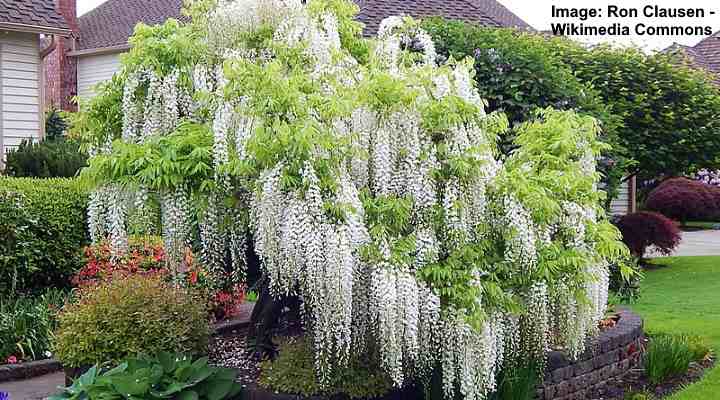
There are two varieties of white flowering wisteria trees: Wisteria sinensis ‘Jako’ and Wisteria floribunda ‘Alba.’ These stunning white wisteria trees bloom with cascading clusters of white racemes measuring up to 24” (60 cm) long. The white floral displays persist on the tree for several weeks from late spring or early summer, followed by long attractive bean pods.
The wisteria tree is a woody twining wisteria vine that is trained to grow as a small tree. The white wisteria tree thrives in full sun to partial shade. A wisteria tree thrives in moist, well-drained, fertile soil and is relatively drought-tolerant once established.
You can grow the drought-tolerant tree as a specimen tree or in a container. As this is a vining plant, you will need to prune it and support its growth as a tree.
Mature Size: Up to 30 ft. (9 m) tall and 20 ft. (6 m) wide
USDA Hardiness Zones: 5 to 9
Sun: Full sun to partial shade
White Flowering Chaste Tree (Vitex agnus-castus ‘Alba’)
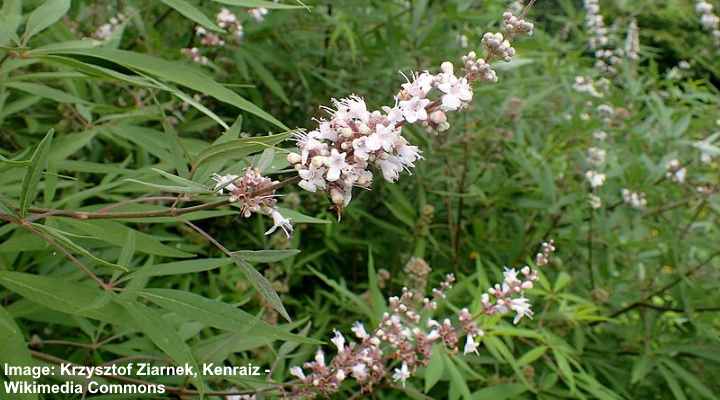
The white flowering ‘Alba’ chaste tree grows as a large multi-stemmed shrub or small tree that blooms in summer with attractive white flowers. The characteristics of this ornamental tree are its white panicles that give off peppery scents. The palmate compound leaves of the ‘Alba’ chaste tree have an earthy fragrance when crushed. Furthermore, this tree produces small black fruits that develop in late summer and fall.
The ‘Alba’ vitex trees have a vase-shaped growth with a rounded crown. ‘Alba’ chaste trees are fast-growing and ideal for cottage gardens, specimen trees, planted near decks or patios, in containers or lining driveways.
Mature Size: 10 – 15 ft. (3 – 4.5 m) high and 15 – 20 ft. (4.5 – 6 m) spread
USDA Hardiness Zones: 7 to 9
Sun: Full sun
Two-Wing Silver Bell (Halesia diptera)
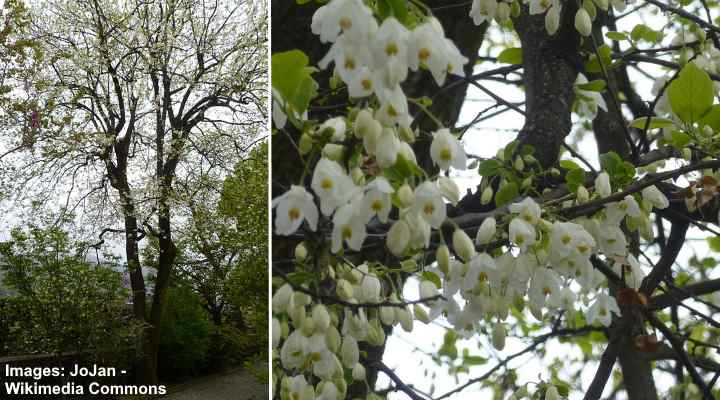
The two-wing silver bell is a stunning white-flowering native Texas tree. The attractive ornamental small tree has clusters of pendulous white flowers blooming in early spring. The tree’s foliage consists of long green oval leaves that turn yellow in the fall before they drop.
The two-wing silver bell can be grown either as a large shrub or trained as a single trunk tree. It thrives in full sun and moist, organically-rich well-drained soil and doesn’t grow well in coastal regions. The decorative landscape tree is ideal as a specimen plant or shrub border.
Mature Size: 20 to 30 ft. (6 – 9 m) tall
USDA Hardiness Zones: 5 to 8
Sun: Full sun
White Jacaranda (Jacaranda mimosifolia Alba)
Jacaranda mimosifolia ‘Alba’ is a beautiful deciduous ornamental tropical tree. The white jacaranda tree is known for its spectacular clusters of white trumpet-shaped flowers that can appear from April or May through August, attractive green fern-like leaves, and a spreading umbrella-like canopy.
The white jacaranda tree is a stunning specimen tree, suitable for medium to large yards. Plant the white jacaranda tree in fertile, rich loamy soil that drains well. Thanks to its beautiful dark green pinnately compound leaves, the tree is useful as a lawn or tree to enjoy dappled shade beneath its spreading canopy.
Mature Size: 25 to 40 ft. (7.6 – 12 m) tall and 45 to 60 ft.(13.7 – 18) spread
USDA Hardiness Zones: 10 to 11
Sun: Full sun
Manna Ash (Fraxinus ornus)
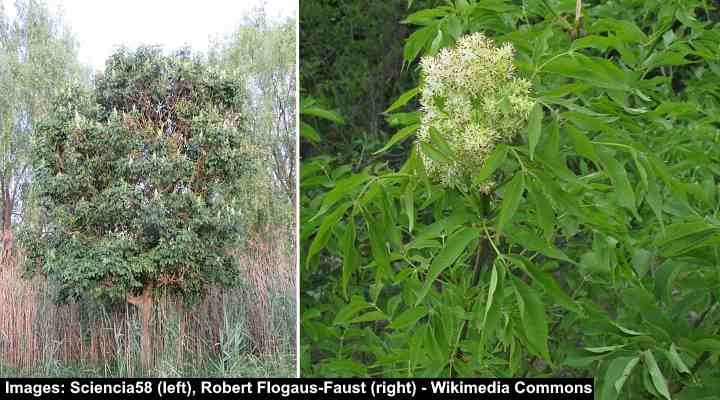
The Manna ash is an attractive medium-sized deciduous tree with dense clusters of fragrant white flowers that bloom in late spring or early summer. The Manna ash is also known for its lush green foliage, featuring compound leaves with a glossy texture that create a lush and vibrant canopy.
Aside from its decorative flowers and foliage, the Manna ash produces small winged seeds, commonly referred to as “helicopters,” and smooth silvery bark.
Grow as an ornamental tree in moist organically rich well drained soil in full sun.
Mature Size: 40–50 ft. (12 – 25 m) tall
USDA Hardiness Zones: 5 to 6
Sun: Full sun
Discover many other types of flowering trees in a variety of colors.
Related articles:

